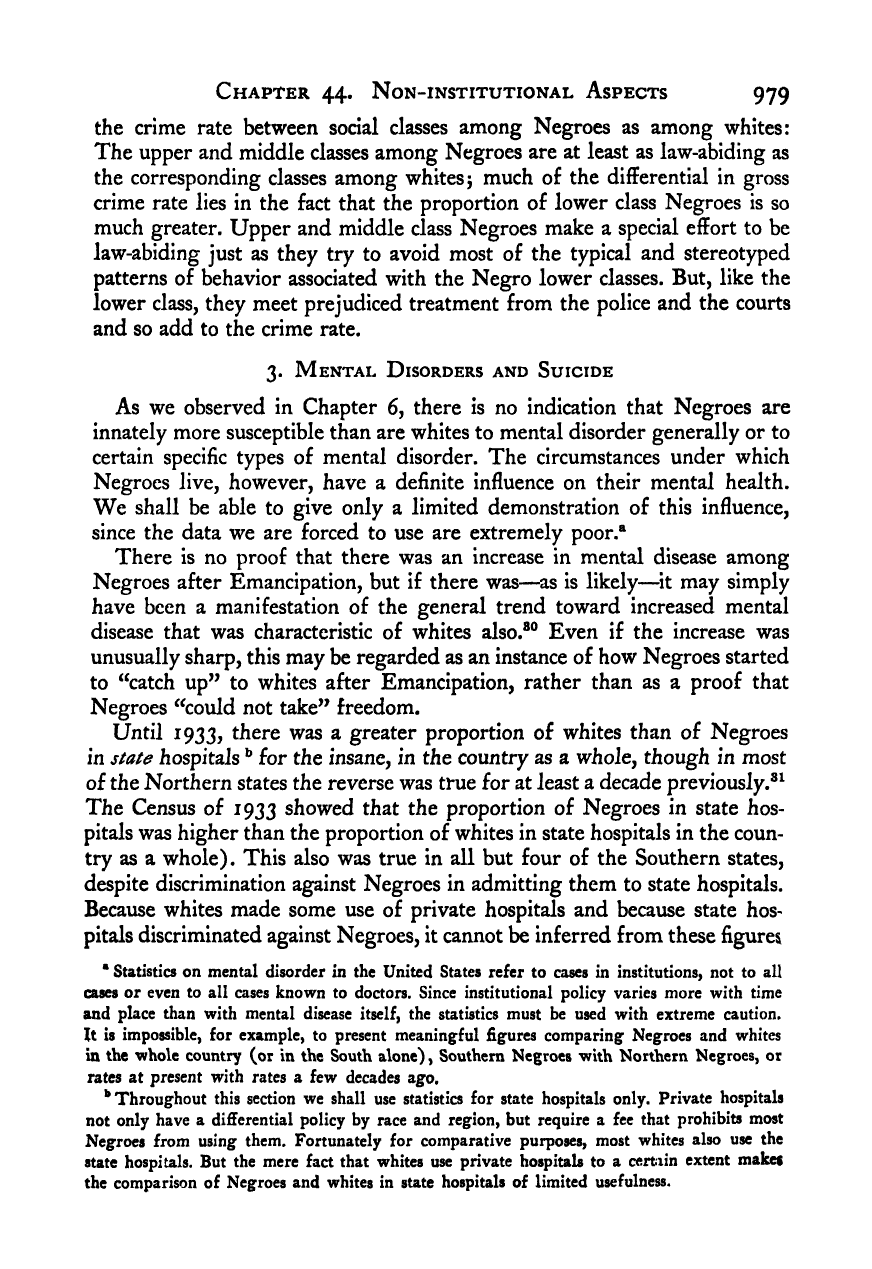Note: Gunnar Myrdal died in 1987, less than 70 years ago. Therefore, this work is protected by copyright, restricting your legal rights to reproduce it. However, you are welcome to view it on screen, as you do now. Read more about copyright.
Full resolution (TIFF) - On this page / på denna sida - X. The Negro Community - 44. Non-Institutional Aspects of the Negro Community - 2. Crime - 3. Mental Disorders and Suicide

<< prev. page << föreg. sida << >> nästa sida >> next page >>
Below is the raw OCR text
from the above scanned image.
Do you see an error? Proofread the page now!
Här nedan syns maskintolkade texten från faksimilbilden ovan.
Ser du något fel? Korrekturläs sidan nu!
This page has never been proofread. / Denna sida har aldrig korrekturlästs.
Chapter 44. Non-institutional Aspects 979
the crime rate between social classes among Negroes as among whites:
The upper and middle classes among Negroes are at least as law-abiding as
the corresponding classes among whites 5
much of the differential in gross
crime rate lies in the fact that the proportion of lower class Negroes is so
much greater. Upper and middle class Negroes make a special effort to be
law-abiding just as they try to avoid most of the typical and stereotyped
patterns of behavior associated with the Negro lower classes. But, like the
lower class, they meet prejudiced treatment from the police and the courts
and so add to the crime rate.
3. Mental Disorders and Suicide
As we observed in Chapter 6, there is no indication that Negroes are
innately more susceptible than are whites to mental disorder generally or to
certain specific types of mental disorder. The circumstances under which
Negroes live, however, have a definite influence on their mental health.
We shall be able to give only a limited demonstration of this influence,
since the data we are forced to use are extremely poor.^
There is no proof that there was an increase in mental disease among
Negroes after Emancipation, but if there was—as is likely—it may simply
have been a manifestation of the general trend toward increased mental
disease that was characteristic of whites also.*® Even if the increase was
unusually sharp, this may be regarded as an instance of how Negroes started
to “catch up” to whites after Emancipation, rather than as a proof that
Negroes “could not take” freedom.
Until 1933, there was a greater proportion of whites than of Negroes
in state hospitals ^ for the insane^ in the country as a whole, though in most
of the Northern states the reverse was true for at least a decade previously.®^
The Census of 1933 showed that the proportion of Negroes in state hos-
pitals was higher than the proportion of whites in state hospitals in the coun-
try as a whole). This also was true in all but four of the Southern states,
despite discrimination against Negroes in admitting them to state hospitals.
Because whites made some use of private hospitals and because state hos-
pitals discriminated against Negroes, it cannot be inferred from these figures
* Statistics on mental disorder in the United States refer to cases in institutions, not to all
cases or even to all cases known to doctors. Since institutional policy varies more with time
and place than with mental disease itself, the statistics must be used with extreme caution.
It is impossible, for example, to present meaningful figures comparing Negroes and whites
in the whole country (or in the South alone) ,
Southern Negroes with Northern Negroes, or
rates at present with rates a few decades ago.
Throughout this section we shall use statistics for state hospitals only. Private hospitals
not only have a differential policy by race and region, but require a fee that prohibits most
Negroes from using them. Fortunately for comparative purposes, most whites also use the
state hospitals. But the mere fact that whites use private hospitals to a certain extent makes
the comparison of Negroes and whites in state hospitals of limited usefulness.
<< prev. page << föreg. sida << >> nästa sida >> next page >>